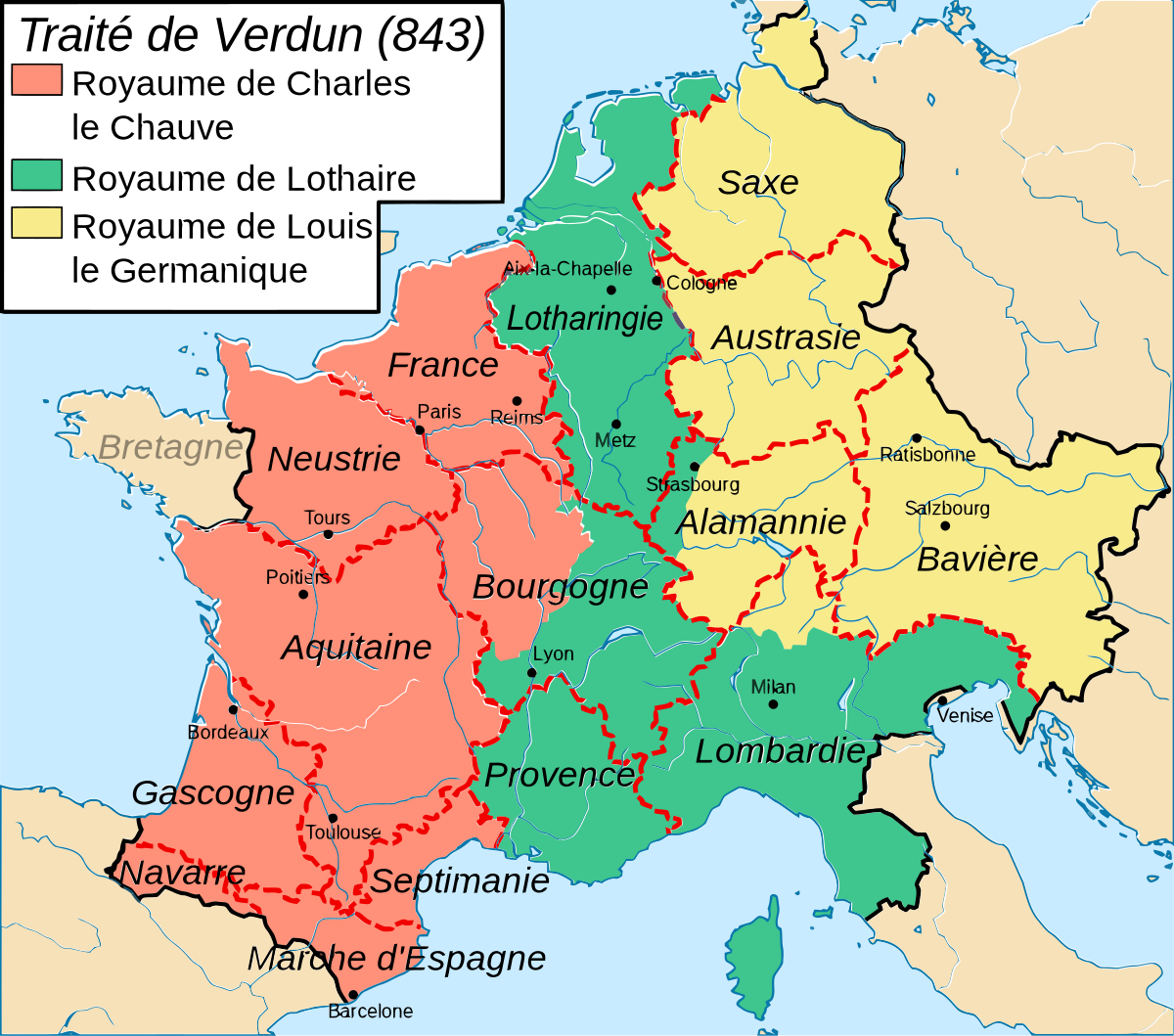The Burgundian Kingdoms
27 December 2021
One of Swiss soil’s most exciting but forgotten kingdoms existed from 888 to 1032. Terminologically, it has been a confusing kingdom.
The First Burgundian Kingdom
The terminological history refers to the first Burgundian kingdom (443-534). This kingdom stretched from Geneva and Basel to the Rhône delta.

The Nibelungen. Source: Wikipedia
After the Frankish empire (534-888) of the Merovingians and Carolingians, Charlemagne’s political inheritance in 843 (Treaty of Verdun) led to unrest. The three sons of Louis the Pious (778-840) divided the Empire of Charlemagne into three parts.
Lothar (795-855) acquired the area of the old Burgundian kingdom (443-543), the so-called Middle Kingdom, which included the Low Countries, Alsace, Lorraine, Luxembourg, Switzerland and Italian territories.

Treaty of Verdun. Source: Wikipedia.
The eastern part, ruled by Louis the German (804-876), developed into present-day Germany, and the western region, governed by Charles the Bold (823-877), roughly speaking, into present-day France.
In the three centuries between 534 and 843, the Burgundians and Franks’ culture, language, and population had merged into a new culture and language, which is now called Old-French.
Despite the fall of the Burgundian kingdom in 534, the Frankish Merovingians and Carolingians continued to call themselves. Kings of Burgundy (regnum Burgundiae), so great was their prestige.
Burgundy as a political unit was an accepted term for different areas and political divisions in later centuries. For example, today’s Burgundy in France is the legacy of this long development.
In the years 843, 879 and 887, there were four political units with the name Burgundy:
the Duchy of Burgundy in the north-west, roughly the area of today’s French Burgundy and the later administrative centre of the illustrious Dukes of Burgundy of the 14th and 15th centuries;
the county of Burgundy, present-day Franche-Comté with Besançon as its main town;
the kingdom of Lower Burgundy (Basse-Bourgogne) in the south, which extended from Geneva to the Rhône delta;
The kingdom of Upper Burgundy (Haute-Bourgogne) stretched across the present-day cantons of Geneva, Vaud, Jura, and the two Basler cantons (Basel-Stadt and Basel-Landschaft).
The Duchy of Burgundy did not last long and fell to the French King in 1004. The county of Burgundy became part of the Kingdom of Arles in 933.
In 879, the Kingdom of Provence (Regnum Provinciae seu Burgundiae or le Royaume de Basse-Bourgogne) arose from the kingdoms of Lower Burgundy and Arles.



The Second Burgundian Kingdom
Ten years later, in 888, the Kingdom of the Jura or Trans-Jurane Burgundy (Regnum Iurense or Burgundia Transiurensis) emerged. The kings were crowned in Payerne.
In 933, the two kingdoms of Lower Burgundy and Trans-Jurane Burgundy gave rise to the kingdom of the two Burgundies, le Royaume des Deux Bourgognes (i.e., Basse-Bourgogne and Haute-Bourgogne), as a result of dynastic marriage politics.
The Kingdom stretched across the present-day cantons of Valais, Vaud, Neuchâtel, Geneva, Basel, Savoie, the Dauphiné and the Rhône Delta to Nice.
The kingdom was a geographical unit, with Zurich to the east (which fell just outside it), Nice to the south, the River Sâone to the west and Basel to the north.
There was a direct connection between the Rhine and the Rhone, with the important trading cities of Basel, Lyon, Geneva, Arles and Marseille.
There was also a particular cultural and linguistic homogeneity. The old Kingdom of Burgundy (443-543) was part of this territory, and the cultural heritage of the Carolingian Empire also created a bond.
In addition, there was a common enemy: the rise of a new empire, the Holy Roman Empire in the north, and the French Kingdom in the west, not to mention sporadic incursions by Hungarian tribes from the east and Saracens from the south in the tenth century.
This kingdom lasted for a century. In 1032, the last King Rudolf III (970-1032) died without an heir. The kingdom was absorbed into the Holy Roman Empire.

The Saane/La Sarine in Freiburg/Fribourg, separating French- and German-speaking Switzerland.
The Burgundian Legacy
However, the French-speaking part of Switzerland strengthened its linguistic identity and culture, and the Franco-German language border in Switzerland did not shift significantly after 1033.
Only the Burgundian wars between 1474 and 1477 and the occupation of French-speaking Vaud in 1536 by the predominantly French-speaking Catholic city of Fribourg (Freiburg) and the German-speaking Protestant city of Bern led to bilingualism and Catholicism or Protestantism in towns and areas.
Source: Nowak, J. , Rüdiger, De Bâle à Marseille: l‘ espace bourguignon à l’ époque rodolphienne, Bazel 2019; G. Kreis, die Geschichte der Schweiz (Bazel, 2014); F. Walter, Une histoire de la Suisse, Neuchâtel, 2009).

